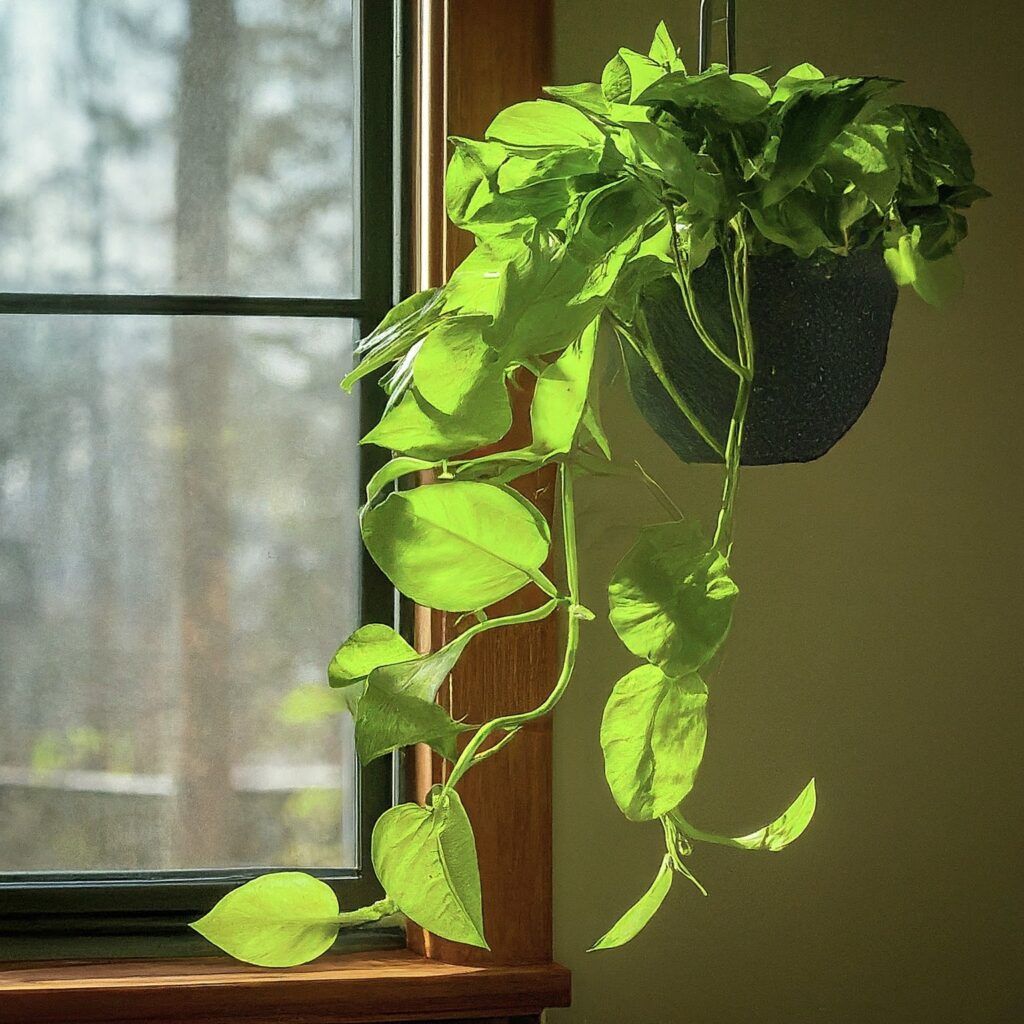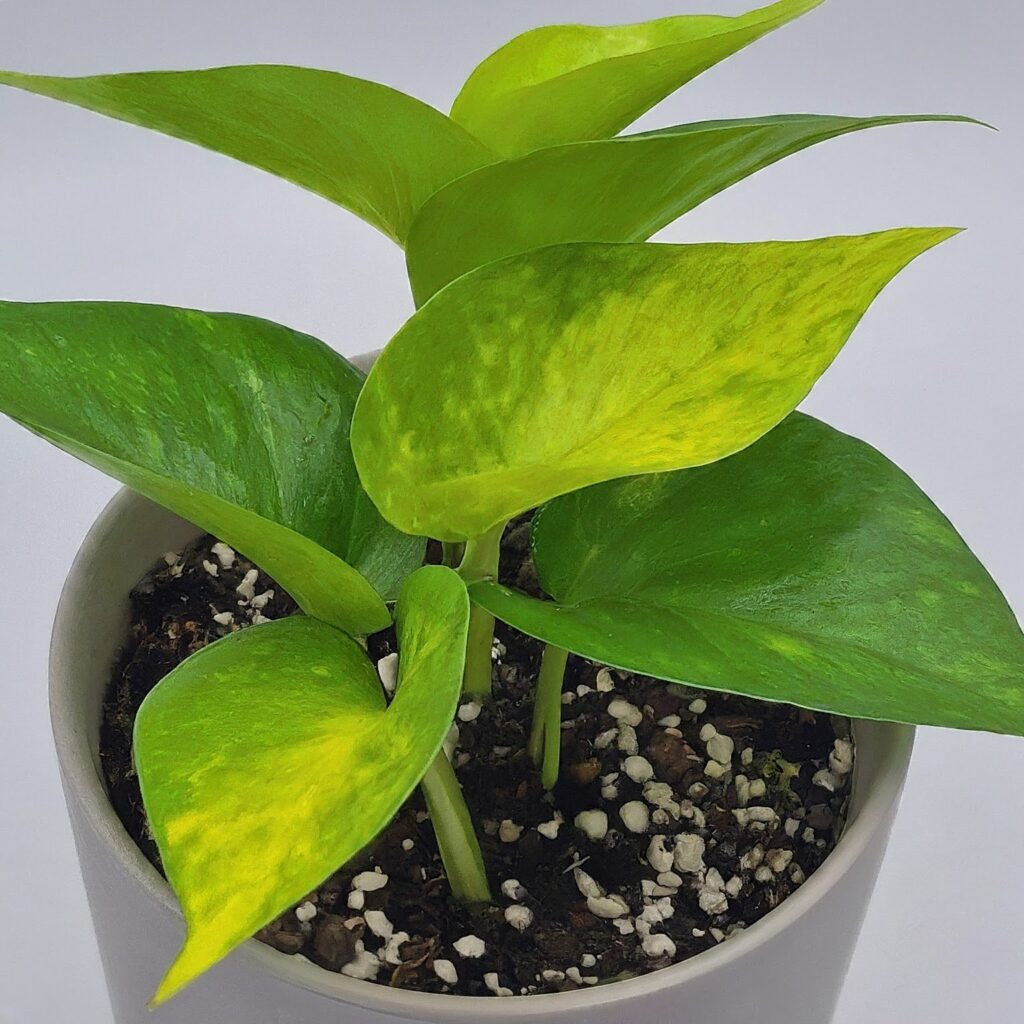Have you ever come across a plant so vibrant that it instantly brightens up your space? Meet the Neon Pothos. With its eye-catching, lime-green leaves, this plant is not just a stunner but also super easy to care for.
Whether you’re a newbie or a seasoned gardener, the Neon Pothos is the perfect addition to your indoor garden. Let’s have a look at our insightful Neon Pothos care guide.
Quick Facts
| Aspect | Details |
| Botanical Name | Epipremnum aureum ‘Neon’ |
| Common Names | Neon Pothos, Electric Pothos |
| Family | Araceae |
| Origin | French Polynesia |
| Plant Type | Perennial Vine |
| Light | Bright, indirect light |
| Watering | Water when the soil’s surface is dry |
| Soil | Well-draining potting mix |
| Temperature | 65-85°F (18-29°C) |
| Humidity | Prefers high humidity, but adaptable |
| Toxicity | Toxic to pets and humans if ingested |
| Propagation | Stem cuttings |
Light Requirements

Neon Pothos loves light, but not just any light. This plant thrives in bright, indirect light. Imagine it basking in the glow near a window, but not directly in the sun’s rays.
Too much direct sunlight can scorch those gorgeous leaves, causing them to turn yellow and crispy. On the flip side, too little light can cause the leaves to lose their vibrant color and slow down the plant’s growth.
If you notice the leaves fading, try moving your plant to a brighter spot.
If you don’t have a bright spot, don’t worry! Neon Pothos can adapt to lower light conditions, though it might grow a bit slower. In such cases, you might consider using a grow light to supplement the natural light.
Soil and Potting Mix
Getting the soil right is a crucial element of Neon Pothos care. This plant prefers a well-draining potting mix. You can whip up your own mix with equal parts peat moss, perlite, and pine bark. This blend ensures your Pothos stays happy by preventing root rot.
Also, be sure to choose a pot with drainage holes—your plant loves to stay moist but hates sitting in water. When potting, ensure the soil is evenly moist but not waterlogged.
Over time, the soil can become compacted, reducing its effectiveness. It’s a good idea to refresh the soil every year to keep your plant thriving.
Watering Needs
When it comes to watering your Neon Pothos, balance is key.
Your plant prefers slightly dry soil. To check if it needs watering, stick your finger about an inch into the soil. If the soil is dry to the touch, water your plant deeply. Also, ensure that the water drains out completely to prevent root rot.
Remember, overwatering can lead to root rot, while underwatering can cause the leaves to wilt and turn brown.
In winter, your plant’s water needs might decrease as growth slows down. This means you should adjust your watering schedule accordingly.
Use room temperature water for your plant because cold water can harm the roots.
Temperature and Humidity
Neon Pothos plants are pretty chill about temperatures, but they do have their preferences. They thrive in temperatures between 65-85°F (18-29°C).
It is always best to keep them away from cold drafts and sudden temperature changes, which can stress the plant and cause leaf drop.
As for humidity, they’re quite adaptable.
However, they love a bit of extra moisture in the air. A little misting now and then or placing your plant near a humidifier can do wonders. If you live in a dry climate, grouping your plants together can help create a more humid microenvironment.
Fertilizing Your Neon Pothos

Feeding your Neon Pothos helps it stay lush and vibrant. It is a good idea to use a balanced, water-soluble fertilizer every 4-6 weeks during the growing season (spring and summer). In doing so, dilute the fertilizer to half the recommended strength for the best results.
You may want to take the DIY route to make nitrogen fertilizer for your Neon Pothos.
But remember not to go overboard with feeding because too much fertilizer can harm your plant.
In fall and winter, when the plant’s growth slows down, you can reduce the feeding frequency or stop altogether. Always follow the manufacturer’s instructions and observe how your plant responds to the feeding.
Potting and Repotting Tips
Your Neon Pothos will eventually outgrow its pot. Repotting every 1-2 years will help keep it healthy and growing.
Look for signs like roots growing out of the drainage holes or soil that dries out quickly. When repotting, choose a pot one size larger and refresh the soil with a new mix.
To repot, carefully remove the plant from its current pot, gently shake off the old soil, and place it in the new pot. Surround the roots with a new potting mix while keeping the plant at its original depth. Then, water it deeply to help it adjust.
Propagating Neon Pothos

One of the joys of owning a Neon Pothos is how easily it propagates.
Here’s a quick guide:
- Cut a healthy vine just below a node (where the leaf meets the stem).
- Place the cutting in water. Make sure the node is submerged.
- Wait for roots to develop. This can take a few weeks.
- Plant the cutting in soil. Keep the soil damp but not soggy.
Propagation is a fun way to expand your collection or share the love with friends. Make sure to change the water every few days to prevent bacterial growth and keep the roots healthy.
Dealing With Pests
Neon Pothos is relatively hardy, but it’s not immune to pests and diseases. As such, it is best to keep an eye out for spider mites, mealybugs, and aphids. If you spot these pests, a quick wipe with a damp cloth or a spray of insecticidal soap can help.
Inspect your plant often, paying close attention to the undersides of leaves for pests. The sooner you spot them, the better your chances of controlling them. For a natural pest control method, consider using neem oil or introducing beneficial insects like ladybugs.
Toxicity Information
If you have pets or young children, it’s essential to know that Neon Pothos is toxic if ingested.
Make sure to keep the plant out of reach and educate your family about its potential risks. If someone does ingest part of the plant, seek medical attention immediately. Symptoms of ingestion can include mouth irritation, swelling, and digestive discomfort.
It’s always better to be safe than sorry. Consider placing your plant on a high shelf or in a hanging planter if you have curious pets or kids around.
Pruning and Maintenance
Pruning helps your Neon Pothos stay full and bushy, besides encouraging new growth. Plus, you can use those cuttings for propagation!
Trim back leggy growth and remove any yellow or damaged leaves. Use sharp, clean scissors or pruning shears to make clean cuts, which reduce the risk of disease.
Comparison With Other Pothos Varieties
Neon Pothos stands out with its striking color, but it’s not the only Pothos variety worth mentioning.
Other popular types include the Golden Pothos with its green and yellow variegation, and the Marble Queen Pothos with its white and green marbled leaves. Each variety has its unique charm, but the care requirements are pretty similar across the board.
Golden Pothos is known for its hardy nature and can tolerate a range of light conditions, making it a versatile choice. Marble Queen, with its stunning variegation, often requires a bit more light to maintain its vibrant patterns.
Mixing different Pothos varieties can add diversity and interest to your plant collection.
Final Thoughts
Caring for a Neon Pothos is straightforward and rewarding. Its vibrant leaves can transform any space, and with the right care, it will thrive for years. Remember to give it the right amount of light, water, and TLC. Happy gardening, and may your Neon Pothos grow lush and vibrant!
FAQs
How often should I water my Neon Pothos?
Water your Neon Pothos when the soil surface is dry. This usually means once a week, but it can vary based on your home’s conditions.
Can Neon Pothos grow in low light?
Yes, but it prefers bright, indirect light. In low light, the leaves might lose some of their vibrancy.
How can I make my Neon Pothos bushier?
Regular pruning encourages new growth, making your plant fuller and bushier.
Is Neon Pothos safe for pets?
No, it’s toxic to pets if ingested.

